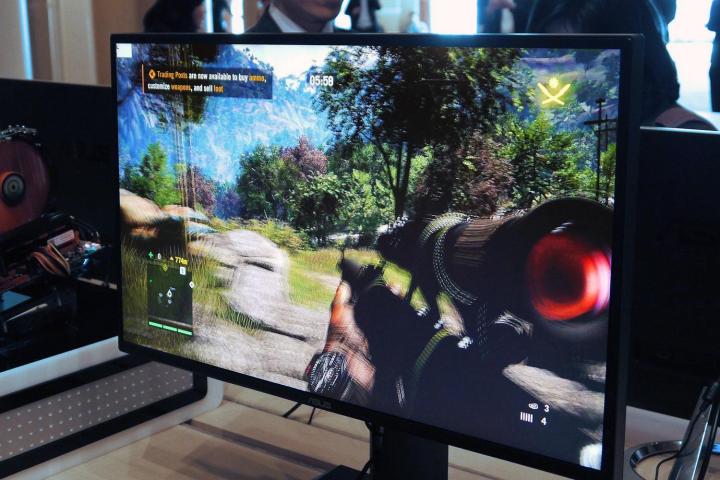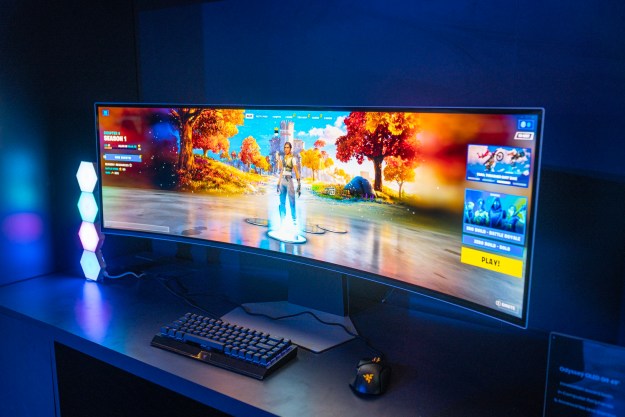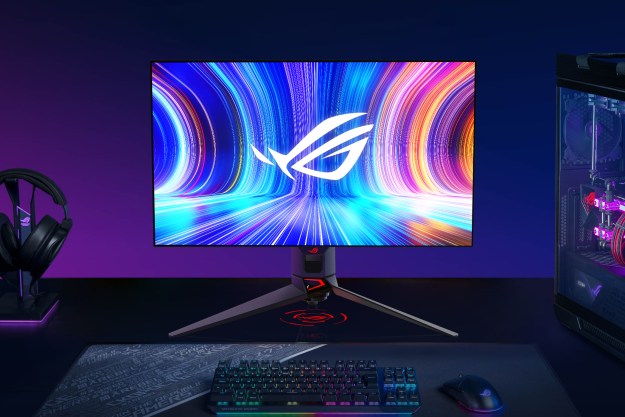
Consumer disinterest can’t be entirely blamed, however. Monitor makers have a long history of putting in as little effort as possible. The task of pushing image quality forward has always fallen on others. Smartphones. Televisions. Tablets.
That trend may be changing at this years CES. Most PC manufacturers have several new monitors with features not available a year before. Some companies, like HP, are showing more monitors than actual computers. Here’s what you should expect from PC displays over the next year.
21:9 carves its niche
Ultra-wide monitors are not new for CES 2015, but they’ve certainly caught on this year like never before. Almost every manufacturer, including heavy hitters like Dell and HP, has embraced this formerly tiny niche.
21:9 monitors have honed in on 34 diagonal inches as magic number. This makes for a display that’s nearly three feet wide, yet still as tall as more conventional 16:9 monitors with a diagonal space of around 28 inches. This is important, as early ultra-wide monitors were smaller and, as a result, had very limited vertical space.
Marketing for these plus-sized displays often focuses on media, as 21:9 is the aspect ratio most movies are filmed at, but ultra-wide also appeals to people with a mind for productivity. The extra horizontal space can be used to display numerous windows, and most models have a picture-by-picture mode that can show two inputs simultaneously.
There are problems with 21:9, too. Not all games support it, the extra horizontal space isn’t always useful, and the 3,440 x 1,440 panels currently in these monitors can’t match the sharpness of 4K. Still, these behemoths are clearly making the leap from novelty to nicety, and some enthusiasts will snap them up for their unique look alone.
4K goes mainstream, 5K matures
Last year’s CES introduced a number of 4K monitors that went on sale in spring, but those models were generally disappointing. Only this fall have we witnessed the first legitimately great 4K displays, like Dell’s P2715Q, show up.
Now that they’re here, though, selection will rapidly mature and prices will fall. The only obstacle in the path to adoption is not hardware, but software; Windows still doesn’t scale as well as it should. With that said, 8.1 looks reasonably crisp on a 28-inch 4K display. Problems are more noticeable on larger panels.
UltraHD has found a foothold in 15-inch notebooks, too, and while its extremely high pixel density makes mobile 4K more niche than with stand-alone monitors it’s hard to go back to mere 1080p or, horror of horrors, 1,366 x 768 once you’ve been spoiled by over 280 pixels per inch.

Then we have the newest hotness: 5K. While it may sound like a minor leap over 4K it in fact boosts pixel count by about 60 percent. More importantly, it offers room for working with 4K images and videos in all their glory with room left over for an editing interface.
5K is held back only by the fact no current connectivity standard can handle it. Apple cheats by using a custom connection, while Dell and HP get around it by using two DisplayPort 1.2 jacks in conjunction. DisplayPort 1.3 will begin to appear later this year, however, and it supports resolutions as high 7,680 x 4,320. Its adoption will open the floodgates to 5K and beyond.
Frame synchronization “fixes” PC games
High-end gaming computers are much faster than any console, but the experience of playing a game on a PC sometimes lags behind what the raw numbers suggest. One reason for this is the variance between the framerate a game puts out and the refresh rate of a monitor. Unsightly tearing and stuttering occurs when a monitor refreshes in the middle of a new frame.
There’s now a solution, however, in frame synchronization. This technology lets properly equipped monitors “talk” with a PC’s video card to ensure new frames are rendered in sync with the refresh rate. Tearing and stuttering is completely eliminated so long the video card used to play is fast enough to reach an acceptable frame rate.
AMD and Nvidia have their own solutions called FreeSync and G-Sync, respectively. Which will ultimately become the standard is hard to say, but the swelling numbers of monitors with support make it clear manufacturers are taking the tech seriously. Perhaps there’ll come a day where frame tearing and other unsightly have been completely eliminated.
Conclusion
The proliferation of displays at this year’s CES is great news for everyone who uses a PC regularly. Better image quality is a trait many people can appreciate, and users can generally upgrade without upgrading other hardware.
There’s also more choice than before. Five years ago the best display for gamers was generally the best for multi-taskers and image editors, as there was limited variation in refresh rates, sizes and panel technology. Now there’s a wide range, from basic 60Hz monitors to 144Hz panels for gamers and high-accuracy Super IPS for professionals.
And isn’t more choice a good thing?
Editors' Recommendations
- The best monitors we saw at CES 2024
- CES 2024: all the GPUs, monitors, and laptops to expect
- Why I’m excited about Dell’s new 120Hz UltraSharp monitors
- CES 2023 is a turning point for the dilemma between TVs and gaming monitors
- The best monitors of CES 2023


